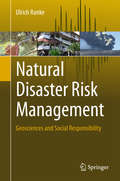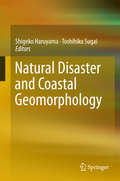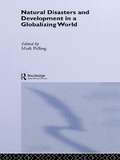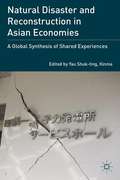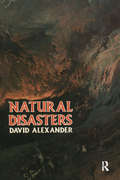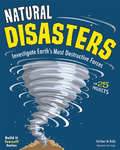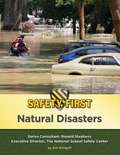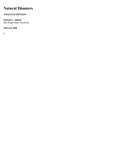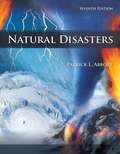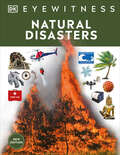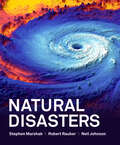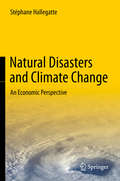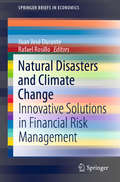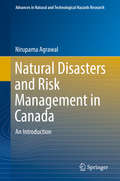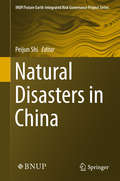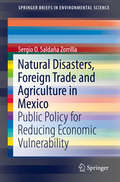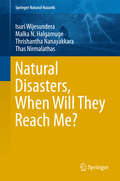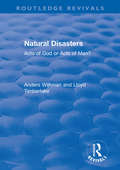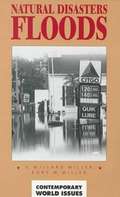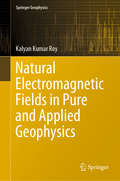- Table View
- List View
Natural Disaster Risk Management
by Ulrich RankeThis textbook provides a thorough introduction to natural disaster risk management. Many aspects of disaster risk management, such as those involved in earthquakes, volcanic eruptions, floods, avalanches and mudslides call for similar prevention and preparedness instruments, management concepts, and countermeasures. This textbook assumes the viewpoint of a regional disaster risk manager who is responsible for a certain area, and for making the lives of the people who live there safer, regardless of the type of natural disaster that may occur. The same holds true for boosting preparedness and awareness in the population at risk. The book includes numerous examples of hazard mitigation concepts and techniques, as well as ways of intensively involving the local population in prevention schemes at an early stage. Furthermore, it provides an in-depth examination of the function of risk communication, both as an instrument for disseminating official information and as a function of public media. In closing, a chapter on risk splitting offers insights into insurance-based models for risk financing. This comprehensive book is a must-read for all students, researchers and practitioners dealing with natural disaster risk management.
Natural Disaster and Coastal Geomorphology
by Shigeko Haruyama Toshihiko SugaiThis book deals with the Tsunami intrusion in the lower plain in the Tohoku region and role played by the coastal and fluvial landforms in the damages. The land-use patterns and the recent urbanization has also been partly responsible for a risk level enhancement. The 2011 East Japan Earthquake and Tsunami has violently hit the coastal plain in the Tohoku and Kanto regions. The coastal geomorphology of these regions have played an important role in the impacts of this natural disaster. The authors introduce tectonic settings, explain and assess these different risks, and discuss future disaster prevention and mitigation planning.
Natural Disaster and Development in a Globalizing World
by Mark PellingThe number of humanitarian disasters triggered by a natural hazard has doubled every decade since the 1960s. At the same time, the global economic growth rate per capita is twice its 1960s value. Does this mean economic growth is independent of the impacts of natural disaster? Natural Disaster and Development in a Globalizing World is the first book to acknowledge the full implications of globalization for disaster and development. The contributors to this book fully examine: global processes and how they might affect disaster risk at the global scale. links between international issues - such as diplomatic relations, the growth of non-governmental organizations and the health of the international insurance industry - and disaster risk the interaction of these large scale forces with local conditions through case study analysis of individual disaster events. In his revealing work, author Pelling makes clear the links between global scale processes and local experiences of disaster, and underlies the difficulty of attributing blame for individual disasters on specific global pressures. He argues that action to reduce disaster must be coordinated at the local, national and global scales and that there is a need for greater integration across the physical and social sciences. In this context, the human rights agenda is seen as a way of moving disaster reduction efforts forward.
Natural Disaster and Reconstruction in Asian Economies
by Yau Shuk-Ting KinniaBased on conference proceedings presented at The Chinese University of Hong Kong in November 2012, Natural Disaster and Reconstruction in Asian Economies offers leading insight into and viewpoints on disasters from scholars and journalists working in Japan, China, the United States, and Southeast Asia.
Natural Disasters
by David AlexanderAs a well balanced and fully illustrated introductory text, this book provides a comprehensive overview of the physical, technological and social components of natural disaster. The main disaster-producing agents are reviewed systematically in terms of geophysical processes and effects, monitoring, mitigation and warning. The relationship between disasters and society is examined with respect to a wide variety of themes, including damage assessment and prevention, hazard mapping, emergency preparedness, the provision of shelter and the nature of reconstruction. Medical emergencies and the epidemiology of disasters are described, and refugee management and aid to the Third World are discussed. A chapter is devoted to the sociology, psychology, economics and history of disasters.; In many parts of the world the toll of death, injury, damage and deprivation caused by natural disasters is becoming increasingly serious. Major earthquakes, volcanic eruptions, droughts, floods and other similar catastrophes are often followed by large relief operations characterized by substantial involvement of the international community. The years 1990-2000 have therefore been designated by the United Nations as the International Decade for Natural Disaster Reduction.; The book goes beyond mere description and elevates the field of natural catastrophes to a serious academic level. The author's insights and perspectives are also informed by his practical experience of being a disaster victim and survivor, and hence the unique perspective of a participant observer. Only by surmounting the boundaries between disciplines can natural catastrophe be understood and mitigation efforts made effective. Thus, this book is perhaps the first completely interdisciplinary, fully comprehensive survey of natural hazards and disasters. It has a clear theoretical basis and it recognizes the importance of six fundamental approaches to the field, which it blends carefully in the text in order to avoid the partiality of previous works. It covers the earth and social sciences, as well as engineering, architecture and development studies. This breadth is made possible by virtue of a strong emphasis on simple principles of the interaction of geophysical agents with human vulnerability and response.; All students of environmental sciences/studies and geography should find this book useful. It is an introductory text which treats this dramatic subject area as something demanding serious academic treatment and not just as an assemblage of horror stories.; This book is intended for undergraduate students in geography and environmental studies/sciences. The book should also appeal to any professional or researcher concerned with man- environment relations, whether in social science or natural science or engineering.
Natural Disasters
by Kathleen M Reilly Tom CasteelWhen natural disasters happen they grab headlines around the world. People, creatures, and the environment are all impacted when nature gets out of control. Natural disasters can be upsetting to live through, but scientists today better understand their causes and how we can protect ourselves and others. Natural Disasters: Investigate Earth's Most Destructive Forces with 25 Projects teaches readers about some of the natural disasters throughout history, what caused them, their impact on civilizations, and how people today cope with natural disasters. Readers of this book will make their own shake tables, create a cake batter lava flow, invent a wind tunnel, and experiment with avalanches. These hands-on activities engage readers and add depth to the text while ensuring that the learning is made lasting and fun.
Natural Disasters
by Kim EtingoffStorms, tornados, floods, wildfires--the world is full of natural disasters that do terrible damage to our homes, towns, and cities. Knowing how to prepare for a natural disaster and what you can do if one does happen is the best way to keep yourself safe.
Natural Disasters
by Patrick L. AbbottNatural Disasters, 12th edition focuses on explaining how the normal processes of Earth concentrate their energies and deal heavy blows to humans and their structures. Students have a natural curiosity about natural disasters and why they occur. This text explains why natural disasters occur by interweaving the themes of Energy sources, Plate tectonics, Climate change, Earth Processes, Geologic time, the complexities of multiple variables operating simultaneously throughout the text.
Natural Disasters (7th edition)
by Patrick Leon AbbottNatural Disasters, 7th edition, focuses on how the normal processes of the Earth concentrate their energies and deal heavy blows to humans and their structures. It is concerned with how the natural world operates and, in so doing, kills and maims humans and destroys their works. Throughout the book, certain themes are maintained: energy sources underlying disasters plate tectonics and climate change; earth processes operating in rock, water, and atmosphere; significance of geologic time; complexities of multiple variables operating simultaneously; detailed and readable case studies.
Natural Disasters (DK Eyewitness Books)
by Claire WattsContains information on tsunamis, earthquakes, landslides, hurricane and other natural disasters.
Natural Disasters (DK Eyewitness)
by DKDiscover the awesome power of nature in this visual guide to the dynamic natural phenomena across our planet.Become an eyewitness to the weird and wonderful ways of our world, from tsunamis to tornadoes, and discover nature's awesome potential with this Eyewitness guide. See how earthquakes, floods and hurricanes affect what lies in their path, and what measures we can use to protect ourselves from Mother Nature. Follow the journey of some of the most catastrophic disasters, and witness the rescue operations that followed. Learn, too, about the equipment used to predict natural disasters, from tsunami magnitude to the earthquake Richter scale and how studies help predict hurricanes, prevent avalanches, control wildfires, and survive earthquakes.Throughout the pages of this newly- revised incredible history book, you can expect to find: -Up to 20 percent new images, including photography and updated diagram-All information updated by expert consultants-Packed with amazing facts, infographics, statistics, and timelines-Includes brand new eyewitness accounts from experts in the fieldThis museum in a book uses striking full-color photographs and illustrations to explore the ancient legends linked to many natural disasters and explains how human activities have caused many other disasters in recent times. A timeline tracing some of the most devastating disasters in history, record-breaking facts, and a guide to some useful online resources makes this a must-have volume for curious children aged 9+ with a thirst for knowledge and learning, alongside teachers, parents and librarians.So, what&’s new? Part of DK&’s best-selling Eyewitness series, this popular title has been reinvigorated for the next generation of information-seekers and stay-at-home explorers, with a fresh new look, up to 20 percent new images, including photography and updated diagrams, updated information, and a new &“eyewitness&” feature with fascinating first-hand accounts from experts in the field.Explore the series!Globally, the Eyewitness series has sold more than 50 million copies over 30 years. Join the journey to combat climate change with Eyewitness Climate Change or take a trip aboard the most famous ship in history with Eyewitness Titanic.
Natural Disasters (First Edition)
by Stephen Marshak Robert Rauber Neil JohnsonA vibrant introduction to the science and societal impacts of disasters. As our planet changes and human population grows, students will see new examples every year of the devastating impact that geologic and atmospheric disasters have on communities. Through vibrant and detailed visuals, engaging writing, and extended case studies, Natural Disasters helps explain the science behind these catastrophes and the societal factors that shape our responses. Step-by-step art makes key concepts accessible to all students. And two case studies in every chapter—covering one North American and one global example and reinforced through online Guided Learning Explorations—get students examining the societal factors that help shape how communities deal with these disasters. This purchase offers access to the digital ebook only.
Natural Disasters Tornadoes
by Louise ParkNatural Disasters: Tornadoes presents the basic scientific principles of how and why tornadoes occur. Case studies of actual events, prevention and warning systems now designed, are both used to show readers the interaction of natural science and human inventiveness .
Natural Disasters and Adaptation to Climate Change
by Sarah Boulter Jean Palutikof David John Karoly Daniela Guitart Sarah Boulter Jean Palutikof David John KarolyThis volume presents eighteen case studies of natural disasters from Australia, Europe, North America and developing countries. By comparing the impacts, it seeks to identify what moves people to adapt, which adaptive activities succeed and which fail, and the underlying reasons, and the factors that determine when adaptation is required and when simply bearing the impact may be the more appropriate response. Much has been written about the theory of adaptation, and high-level, especially international, policy responses to climate change. This book aims to inform actual adaptation practice - what works, what does not, and why. It explores some of the lessons we can learn from past disasters and the adaptation that takes place after the event in preparation for the next. This volume will be especially useful for researchers and decision makers in policy and government concerned with climate change adaptation, emergency management, disaster risk reduction, environmental policy and planning.
Natural Disasters and Climate Change
by Stéphane HallegatteThis book explores economic concepts related to disaster losses, describes mechanisms that determine the economic consequences of a disaster, and reviews methodologies for making decisions regarding risk management and adaptation. The author addresses the need for better understanding of the consequences of disasters and reviews and analyzes three scientific debates on linkage between disaster risk management and adaptation to climate change. The first involves the existence and magnitude of long-term economic impact of natural disasters on development. The second is the disagreement over whether any development is the proper solution to high vulnerability to disaster risk. The third debate involves the difficulty of drawing connections between natural disasters and climate change and the challenge in managing them through an integrated strategy. The introduction describes economic views of disaster, including direct and indirect costs, output and welfare losses, and use of econometric tools to measure losses. The next section defines disaster risk, delineates between "good" and "bad" risk-taking, and discusses a pathway to balanced growth. A section entitled "Trends in Hazards and the Role of Climate Change" sets scenarios for climate change analysis, discusses statistical and physical models for downscaling global climate scenarios to extreme event scenarios, and considers how to consider extremes of hot and cold, storms, wind, drought and flood. Another section analyzes case studies on hurricanes and the US coastline; sea-level rises and storm surge in Copenhagen; and heavy precipitation in Mumbai. A section on Methodologies for disaster risk management includes a study on cost-benefit analysis of coastal protections in New Orleans, and one on early-warning systems in developing countries. The next section outlines decision-making in disaster risk management, including robust decision-making, No-regret and No-risk strategies; and strategies that reduce time horizons for decision-making. Among the conclusions is the assertion that risk management policies must recognize the benefits of risk-taking and avoid suppressing it entirely. The main message is that a combination of disaster-risk-reduction, resilience-building and adaptation policies can yield large potential gains and synergies.
Natural Disasters and Climate Change: Innovative Solutions in Financial Risk Management (SpringerBriefs in Economics)
by Juan José Durante Rafael RosilloThis book presents a technical approach to promoting the development of disaster and climate change risk financing and transfer strategies, and discusses several practical issues, chiefly focusing on Latin America and the Caribbean. Innovative risk financing and insurance mechanisms are vital for governments around the world, in order to provide financial protection and reduce the economic costs and social and developmental impacts of natural disasters and climate change. The book’s main content is complemented by a wealth of graphics, diagrams and tables that illustrate the concepts discussed and make the text accessible for practitioners and non-practitioners alike. The book offers proven, creative and innovative ideas on how to tackle risk financing and management for natural disasters and climate change. Strategic topics such as sovereign disaster risk financing, property catastrophe risk insurance, and agricultural insurance are also discussed.
Natural Disasters and Risk Management in Canada: An Introduction (Advances In Natural And Technological Hazards Research #49)
by Nirupama AgrawalThese chapters provide valuable and comprehensive information on a variety of hazards, including both scientific and social aspects of disasters. The work introduces the concept of large, medium and small scale hazards, and includes many useful case studies as well as working examples of theoretical concepts.As readers will acknowledge, today the distinction between natural and technological hazards is becoming blurred and a new concept of NATECH hazards is evolving. For permanent hazards (such as tides, wind waves, coastal erosion and climate change) routine predictions are made, whereas for evanescent hazards (including droughts, sea level rise, and coastal subsidence), monitoring of various parameters is the norm. Only for episodic hazards (for example hurricanes, winter storms, tsunamis, and river floods), early warning systems are used, with varying degrees of success.The book explores how, for certain episodic hazards like tornadoes, landslides, forest fires, snow avalanches, and volcanic eruptions, the early warning systems are still in various stages of development. Readers will gain knowledge of theoretical and practical concepts of risk evaluation which assist in better understanding of disaster dynamics, and readers will become better equipped in quantification of disaster risk and vulnerability. The author explains how risk reduction initiatives, taking into account stakeholders’ participation and perception, can provide a roadmap to building resilient communities and cities.This book will be useful not only to practitioners of disaster management but also to research scholars and graduate students. It is highly readable and will appeal more broadly too, to all those who are interested in the very latest thinking on, and expert analysis of, hazards and disasters.
Natural Disasters in China
by Peijun ShiThis is the first English language book that systematically introduces the spatial and temporal patterns of major natural disasters in China from 1949 to 2014. It also reveals natural disaster formation mechanisms and processes, quantifies vulnerability to these disasters, evaluates disaster risks, summarizes the key strategies of integrated disaster risk governance, and analyzes large-scale disaster response cases in recent years in China. The book can be a good reference for researchers, students, and practitioners in the field of natural disaster risk management and risk governance for improving the understanding of natural disasters in China.
Natural Disasters in the Ottoman Empire
by Yaron AyalonThis book explores the history of natural disasters in the Ottoman Empire and the responses to them on the state, communal, and individual levels. Yaron Ayalon argues that religious boundaries between Muslims and non-Muslims were far less significant in Ottoman society than commonly believed. Furthermore, the emphasis on Islamic principles and the presence of Islamic symbols in the public domain were measures the state took to enhance its reputation and political capital occasional discrimination of non-Muslims was only a by-product of these measures. This study sheds new light on flight and behavioral patterns in response to impending disasters by combining historical evidence with studies in social psychology and sociology. Employing an approach that mixes environmental and social history with the psychology of disasters, this work asserts that the handling of such disasters was crucial to both the rise and the fall of the Ottoman Empire. "
Natural Disasters, Foreign Trade and Agriculture in Mexico
by Sergio O. Saldaña ZorrillaThis work responds to the increasing global need of measuring and analyzing impacts, vulnerabilities and coping capacity of countries, regions and communities regarding climate change, extreme weather conditions, natural disasters and institutional constraints. The case of Mexico, analyzed in this work, provides lessons for further developing countries to assess natural disasters vulnerability, for making informed adaptation decisions and to optimize resources for reducing country and community vulnerability. This book's analyses contribute to the current debate of the long-term economic impact of natural disasters (hurricanes, earthquakes, etc. ), as well as offer an integral methodology combining natural and social sciences for studies of country and community level vulnerability to climate change. The lessons derived from this analysis provide useful elements for the design and improvement of governmental policies concerning social and economic development as well. In addition, the desegregation of this analysis has the advantage of facilitating the design and evaluation of governmental projects at municipal, sub-national and national level, as well as provides conceptual-empirical elements for international cooperation in matters of disaster risk reduction, climate change adaptation, rural development and poverty reduction.
Natural Disasters, When Will They Reach Me?
by Isuri Wijesundera Malka N. Halgamuge Thrishantha Nanayakkara Thas NirmalathasThe expected time of impact, also known as the mean first passage time (MFPT) to reach failure, is a critical metric in the management of natural disasters. The complexity of the dynamics governing natural disasters lead to stochastic behaviour. This book shows that state transitions of many such systems translate into random walks on their respective state spaces, biased and shaped by environmental inhomogeneity. Thus the probabilistic treatment of those random walks gives valuable insights of expected behaviour. A comprehensive case study of predicting cyclone induced flood is followed by a discussion of generic methods that predict MFPT addressing directional bias. This is followed by discussing MFPT prediction methods in systems showing network inhomogeneity. All presented methods are illustrated using real datasets of natural disasters. The book ends with a short discussion of possible future research areas introducing the problem of predicting MFPT for bush-fire propagation.
Natural Disasters: Acts of God or Acts of Man? (Routledge Revivals)
by Anders Wijkman Lloyd TimberlakeOriginally published in 1984 Natural Disasters shows how misleading the term “natural disaster” can be. Forces of nature such as earthquakes, cyclones and extreme variations in weather can trigger disasters, but in many Third World countries it is environmental degradation, poverty and rapid population growth which turn a natural hazard into major disaster. This book questions whether the rich nations’ usual response to disaster – fast, short-lived emergency assistance – is any longer adequate. Today, most major disasters are “development” gone wrong, development which puts millions of poor people on the margins of existence. Disaster relief alone is like bandaging a rapidly growing wound. The appropriate response must include an element of true development – development which reduces rather than increases vulnerability to disasters.
Natural Disasters: Floods
by E. Willard Miller Ruby M. MillerThe Millers (geography, Pennsylvania State University) discuss the origin of floods, their prediction and control, floodplain management, and insurance. Floods are classified according to origin: excessive rain from hurricanes, undersea earthquakes, and wind-driven tidal waves. Also included are chapters on organizations devoted to flood problems, and relevant laws and regulations. Special attention is given to the midwest flood of 1993, the Johnstown flood (1889), the Big Thompson Canyon flood (1972) and the Susquehanna River flood (1972). A bibliography, a list of audio-visual materials, and a glossary complete the volume. Annotation c. Book News, Inc., Portland, OR (booknews.com)
Natural Draught Cooling Towers: Proceedings of the Fifth International Symposium on Natural Draught Cooling Towers, Istanbul, Turkey, 20-22 May 2004
by I. Mungan U. WittekThe world's most experienced scientists and professionals working on cooling towers gathered at the 5th International Symposium on Natural Draught Cooling Towers to discuss the latest developments in this area and exchange knowledge and experiences. This book comprises 43 contributions on the latest developments in the field of natural draught cool
Natural Electromagnetic Fields in Pure and Applied Geophysics (Springer Geophysics)
by Kalyan Kumar RoyThis research monograph presents all the branches of geophysics based on natural electromagnetic fields and their associated subjects. Meant for postgraduate and research level courses, it includes research guidance and collection of magnetotelluric data in some parts of Eastern India and their qualitative and quantitative interpretation. Specific topics highlighted include (i) Electrotellurics, (ii) Magnetotellurics, (iii) Geomagnetic Depth Sounding and Magnetometer Array Studies, (iv) Audio Frequency Magnetotellurics and Magnetic Methods, (v) Marine Magnetotelluric and Marine Controlled Source Electromagnetic Methods, (vi) Electrical Conductivity of Rocks and Minerals and (vii) Mathematical Modelling and Some Topics on Inversion needed for Interpretation of Geoelectrical Data.
